tow TOYOTA RAV4 2012 XA30 / 3.G Owners Manual
[x] Cancel search | Manufacturer: TOYOTA, Model Year: 2012, Model line: RAV4, Model: TOYOTA RAV4 2012 XA30 / 3.GPages: 544, PDF Size: 10.25 MB
Page 1 of 544
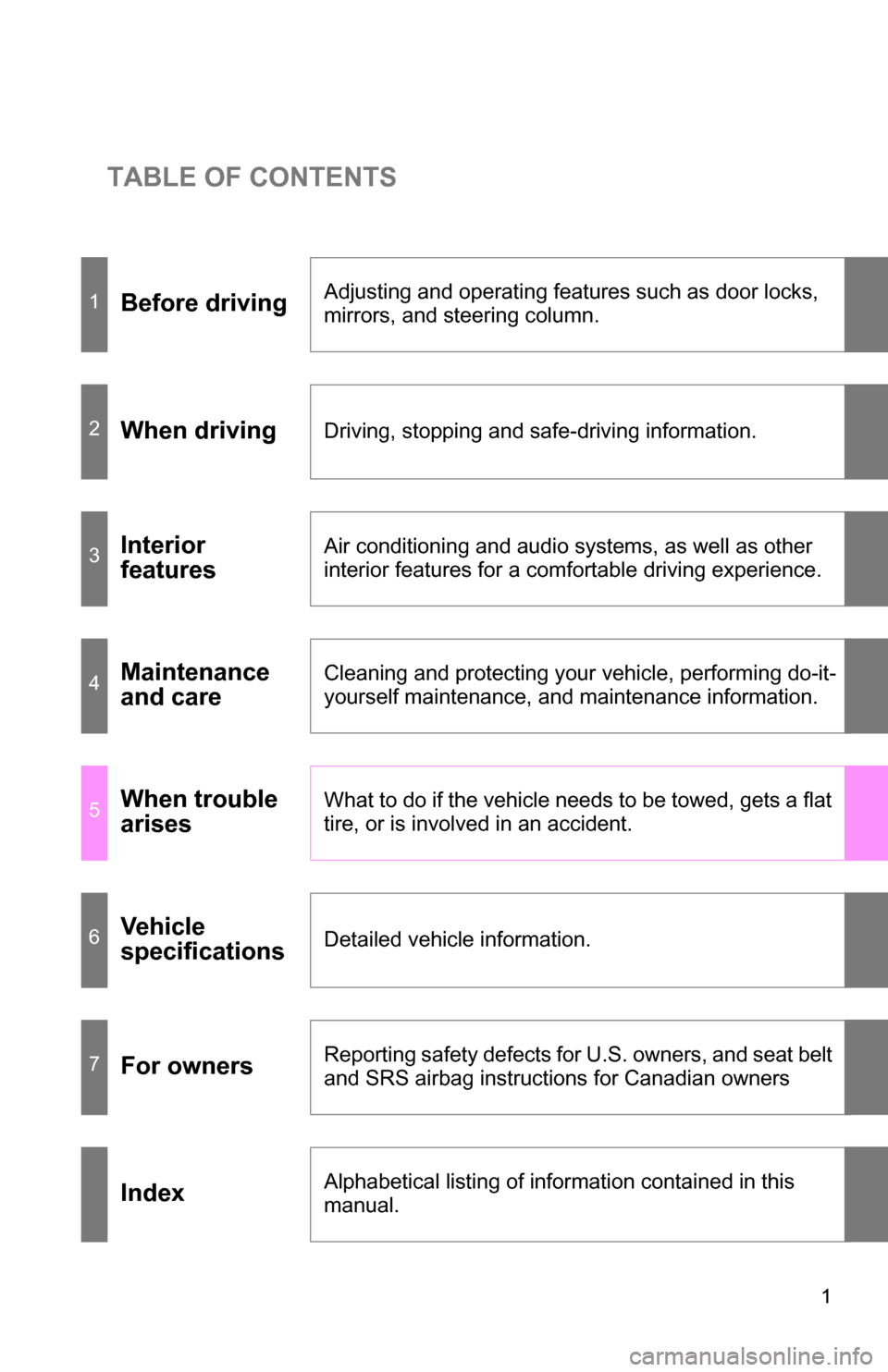
TABLE OF CONTENTS
1
1Before drivingAdjusting and operating features such as door locks,
mirrors, and steering column.
2When drivingDriving, stopping and safe-driving information.
3Interior
featuresAir conditioning and audio systems, as well as other
interior features for a comfortable driving experience.
4Maintenance
and careCleaning and protecting your vehicle, performing do-it-
yourself maintenance, and maintenance information.
5When trouble
arisesWhat to do if the vehicle needs to be towed, gets a flat
tire, or is involved in an accident.
6Vehicle
specificationsDetailed vehicle information.
7For ownersReporting safety defects for U.S. owners, and seat belt
and SRS airbag instructions for Canadian owners
IndexAlphabetical listing of information contained in this
manual.
Page 3 of 544
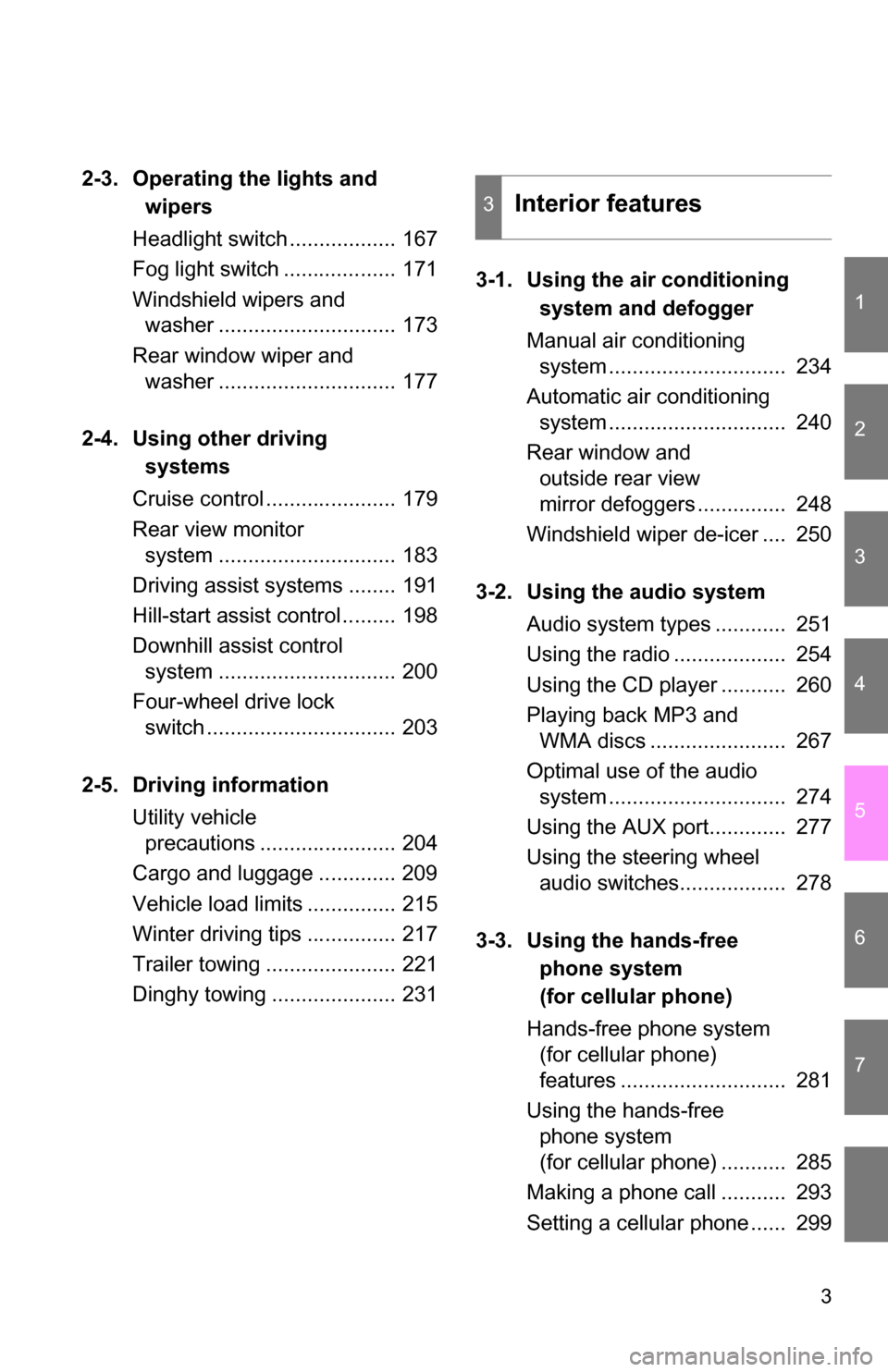
1
2
3
4
5
6
7
3
2-3. Operating the lights and wipers
Headlight switch .................. 167
Fog light switch ................... 171
Windshield wipers and washer .............................. 173
Rear window wiper and washer .............................. 177
2-4. Using other driving systems
Cruise control ...................... 179
Rear view monitor system .............................. 183
Driving assist systems ........ 191
Hill-start assist control ......... 198
Downhill assist control system .............................. 200
Four-wheel drive lock switch ................................ 203
2-5. Driving information Utility vehicle precautions ....................... 204
Cargo and luggage ............. 209
Vehicle load limits ............... 215
Winter driving tips ............... 217
Trailer towing ...................... 221
Dinghy towing ..................... 231 3-1. Using the air conditioning
system and defogger
Manual air conditioning system .............................. 234
Automatic air conditioning system .............................. 240
Rear window and outside rear view
mirror defoggers ............... 248
Windshield wiper de-icer .... 250
3-2. Using the audio system Audio system types ............ 251
Using the radio ................... 254
Using the CD player ........... 260
Playing back MP3 and WMA discs ....................... 267
Optimal use of the audio system .............................. 274
Using the AUX port............. 277
Using the steering wheel audio switches.................. 278
3-3. Using the hands-free phone system
(for cellular phone)
Hands-free phone system (for cellular phone)
features ............................ 281
Using the hands-free phone system
(for cellular phone) ........... 285
Making a phone call ........... 293
Setting a cellular phone ...... 299
3Interior features
Page 5 of 544
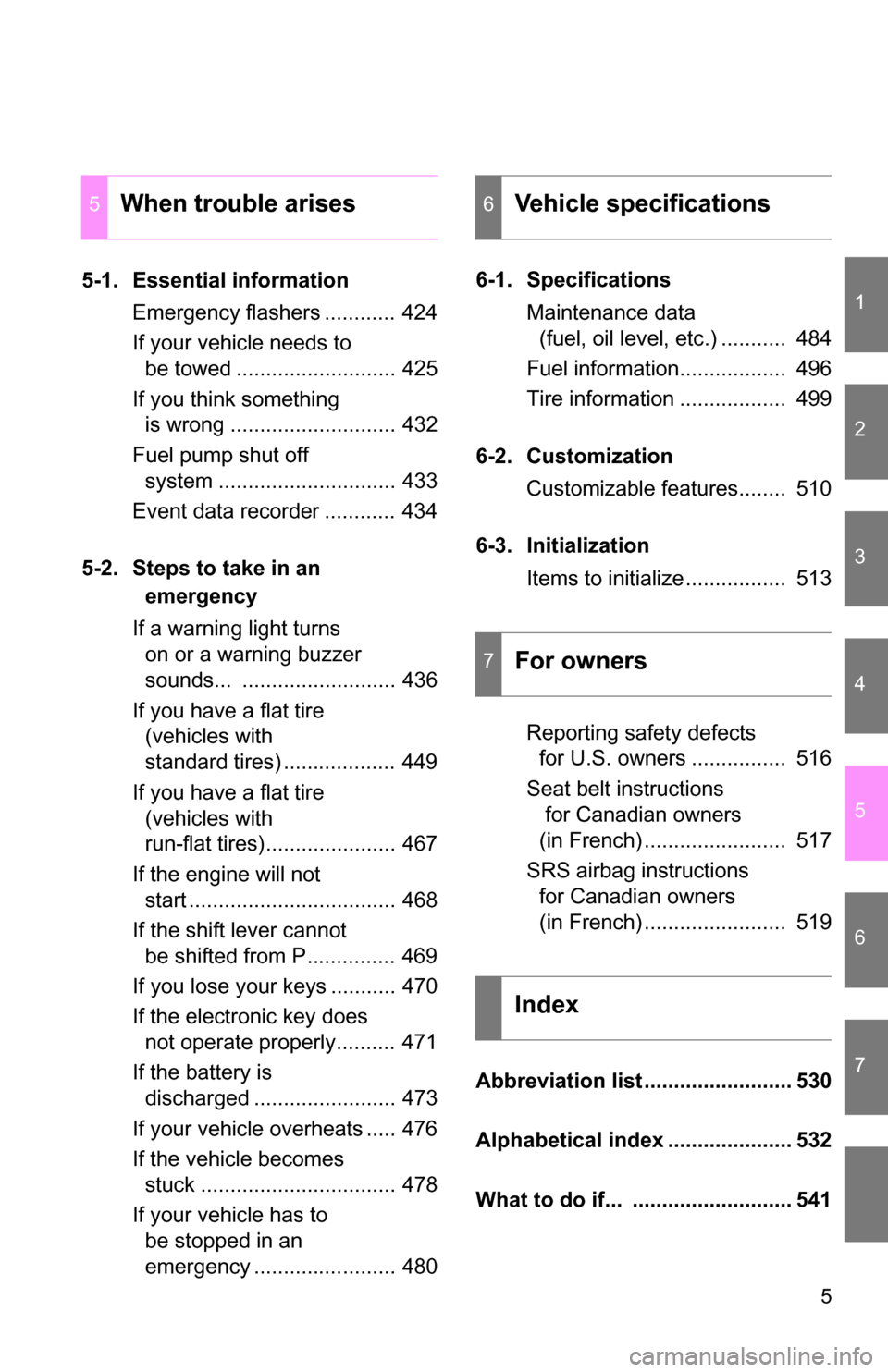
1
2
3
4
5
6
7
5
5-1. Essential informationEmergency flashers ............ 424
If your vehicle needs to be towed ........................... 425
If you think something is wrong ............................ 432
Fuel pump shut off system .............................. 433
Event data recorder ............ 434
5-2. Steps to take in an emergency
If a warning light turns on or a warning buzzer
sounds... .......................... 436
If you have a flat tire (vehicles with
standard tires) ................... 449
If you have a flat tire (vehicles with
run-flat tires)...................... 467
If the engine will not start ................................... 468
If the shift lever cannot be shifted from P............... 469
If you lose your keys ........... 470
If the electronic key does not operate properly.......... 471
If the battery is discharged ........................ 473
If your vehicle overheats ..... 476
If the vehicle becomes stuck ................................. 478
If your vehicle has to be stopped in an
emergency ........................ 480 6-1. Specifications
Maintenance data (fuel, oil level, etc.) ........... 484
Fuel information.................. 496
Tire information .................. 499
6-2. Customization Customizable features........ 510
6-3. Initialization Items to initialize ................. 513
Reporting safety defects for U.S. owners ................ 516
Seat belt instructions for Canadian owners
(in French) ........................ 517
SRS airbag instructions for Canadian owners
(in French) ........................ 519
Abbreviation list ......................... 530
Alphabetical index ..................... 532
What to do if... ........................... 541
5When trouble arises6Vehicle specifications
7For owners
Index
Page 30 of 544
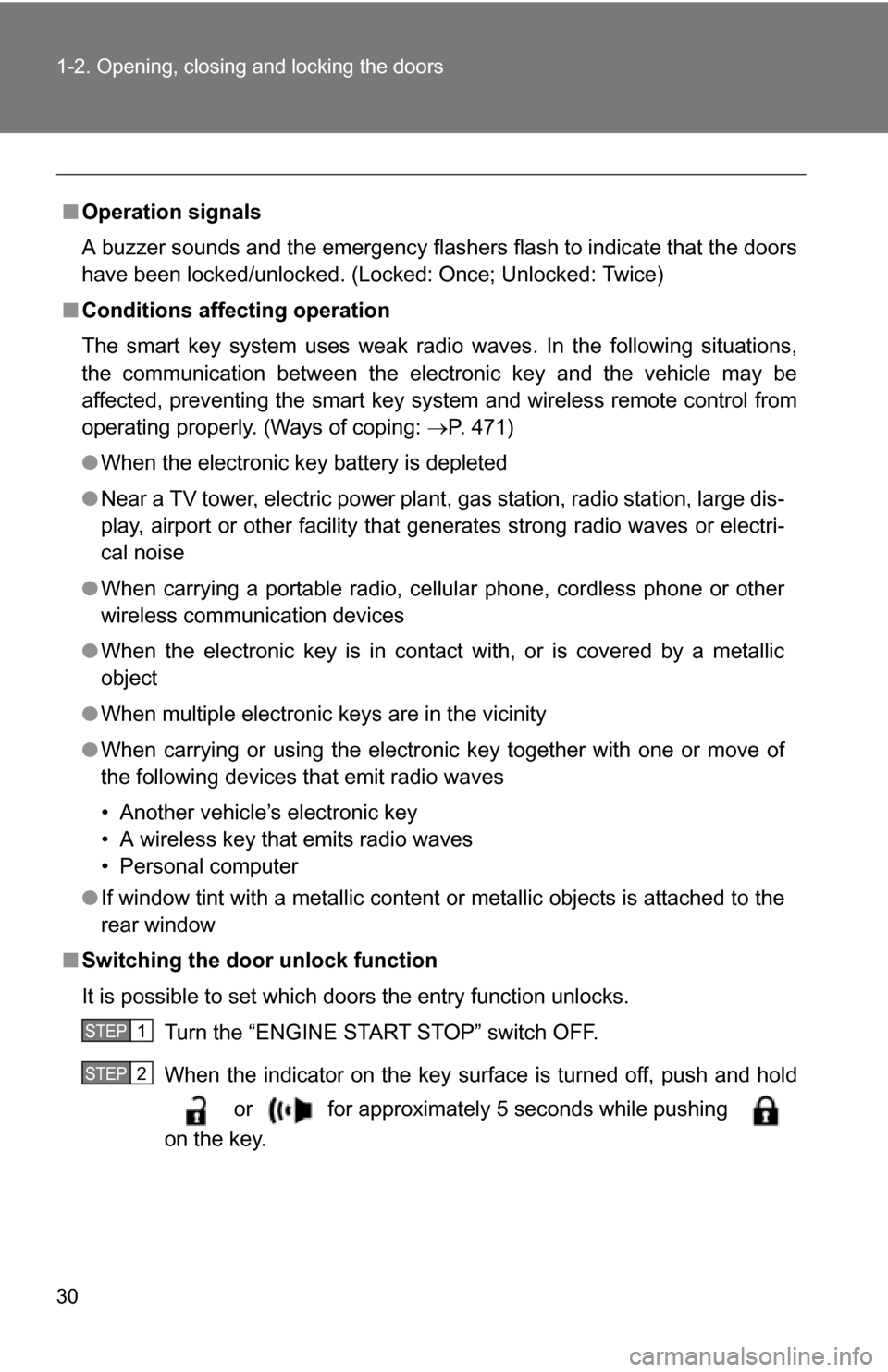
30 1-2. Opening, closing and locking the doors
■Operation signals
A buzzer sounds and the emergency flashers flash to indicate that the doors
have been locked/unlocked. (Locked: Once; Unlocked: Twice)
■ Conditions affecting operation
The smart key system uses weak radio waves. In the following situations,
the communication between the electronic key and the vehicle may be
affected, preventing the smart key system and wireless remote control from
operating properly. (Ways of coping: P. 471)
● When the electronic key battery is depleted
● Near a TV tower, electric power plant, gas station, radio station, large dis-
play, airport or other facility that generates strong radio waves or electri-
cal noise
● When carrying a portable radio, ce llular phone, cordless phone or other
wireless communication devices
● When the electronic key is in contact with, or is covered by a metallic
object
● When multiple electronic keys are in the vicinity
● When carrying or using the electronic key together with one or move of
the following devices that emit radio waves
• Another vehicle’s electronic key
• A wireless key that emits radio waves
• Personal computer
● If window tint with a metallic content or metallic objects is attached to the
rear window
■ Switching the door unlock function
It is possible to set which doors the entry function unlocks.
Turn the “ENGINE START STOP” switch OFF.
When the indicator on the key surface is turned off, push and hold or for approximately 5 seconds while pushing
on the key.
STEP 1
STEP 2
Page 40 of 544
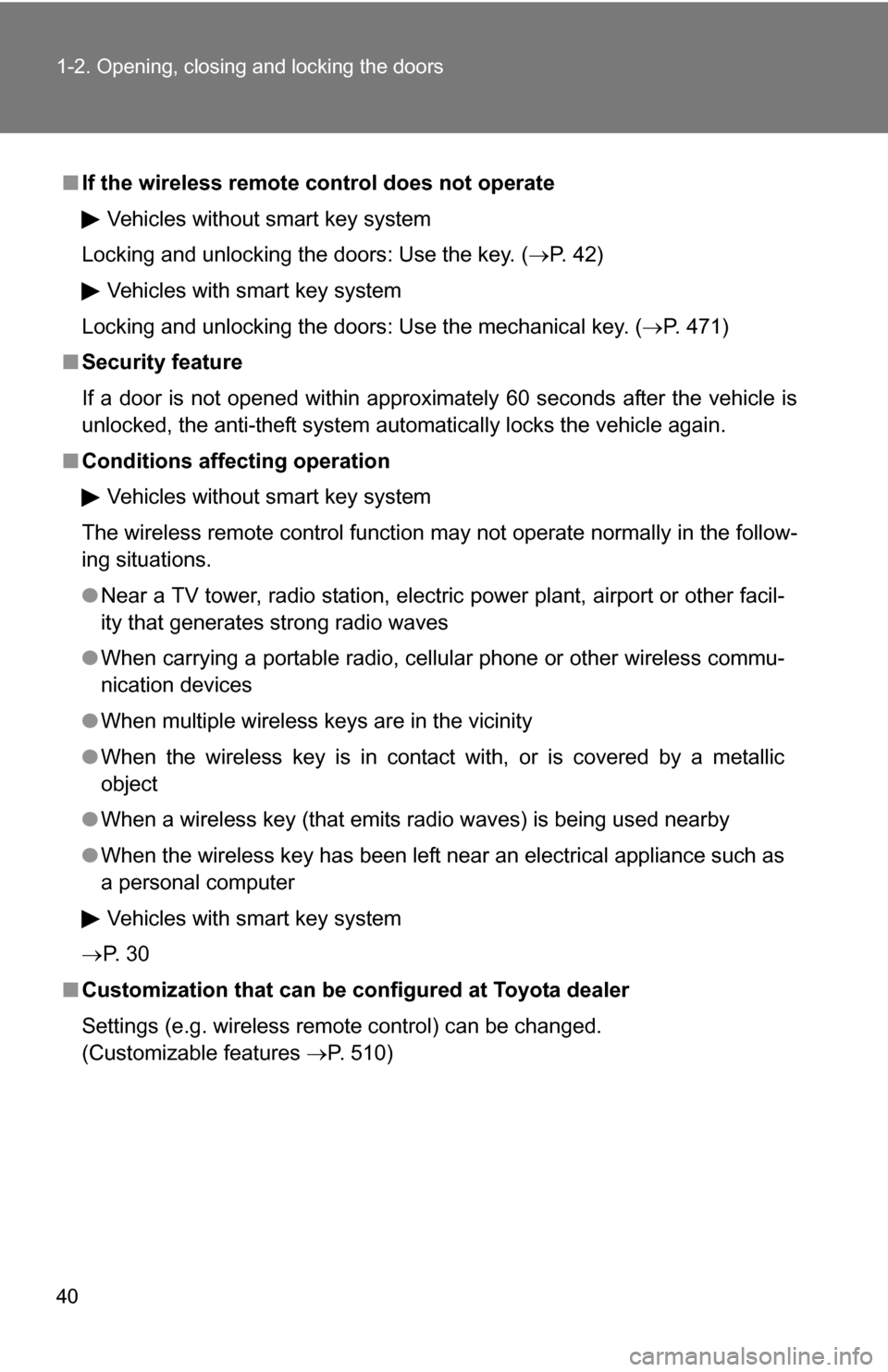
40 1-2. Opening, closing and locking the doors
■If the wireless remote control does not operate
Vehicles without smart key system
Locking and unlocking the doors: Use the key. ( P. 42)
Vehicles with smart key system
Locking and unlocking the doors: Use the mechanical key. ( P. 471)
■ Security feature
If a door is not opened within approximately 60 seconds after the vehicle is
unlocked, the anti-theft system automatically locks the vehicle again.
■ Conditions affecting operation
Vehicles without smart key system
The wireless remote control function may not operate normally in the follow-
ing situations.
● Near a TV tower, radio station, electr ic power plant, airport or other facil-
ity that generates strong radio waves
● When carrying a portable radio, cell ular phone or other wireless commu-
nication devices
● When multiple wireless keys are in the vicinity
● When the wireless key is in contact with, or is covered by a metallic
object
● When a wireless key (that emits radio waves) is being used nearby
● When the wireless key has been left near an electrical appliance such as
a personal computer
Vehicles with smart key system
P. 3 0
■ Customization that can be co nfigured at Toyota dealer
Settings (e.g. wireless remote control) can be changed.
(Customizable features P. 510)
Page 58 of 544
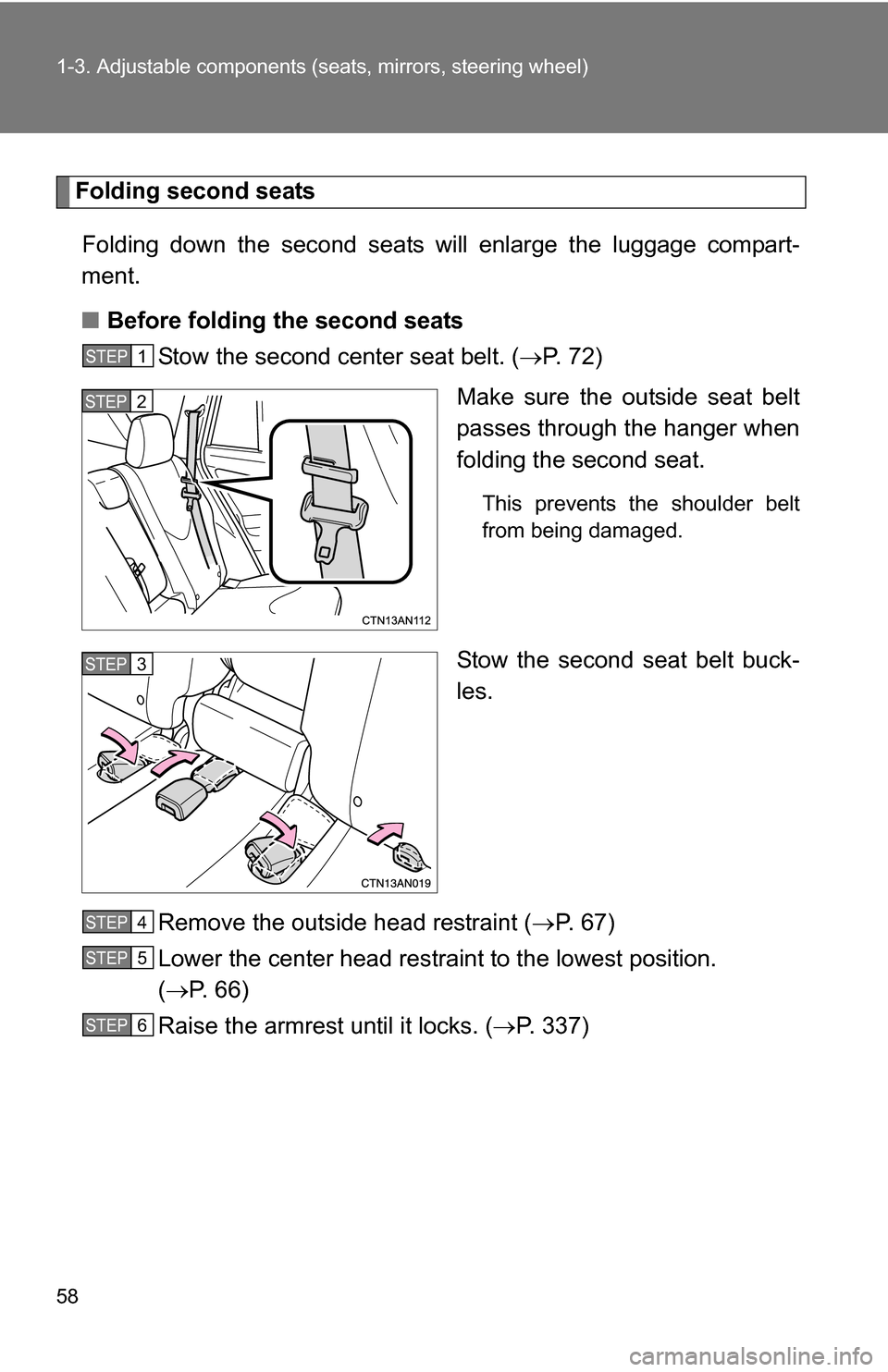
58 1-3. Adjustable components (seats, mirrors, steering wheel)
Folding second seats
Folding down the second seats will enlarge the luggage compart-
ment.
■ Before folding the second seats
Stow the second center seat belt. ( P. 72)
Make sure the outside seat belt
passes through the hanger when
folding the second seat.
This prevents the shoulder belt
from being damaged.
Stow the second seat belt buck-
les.
Remove the outside head restraint ( P. 6 7 )
Lower the center head restraint to the lowest position.
( P. 6 6 )
Raise the armrest until it locks. ( P. 337)
STEP 1
STEP 2
STEP 3
STEP 4
STEP 5
STEP 6
Page 60 of 544
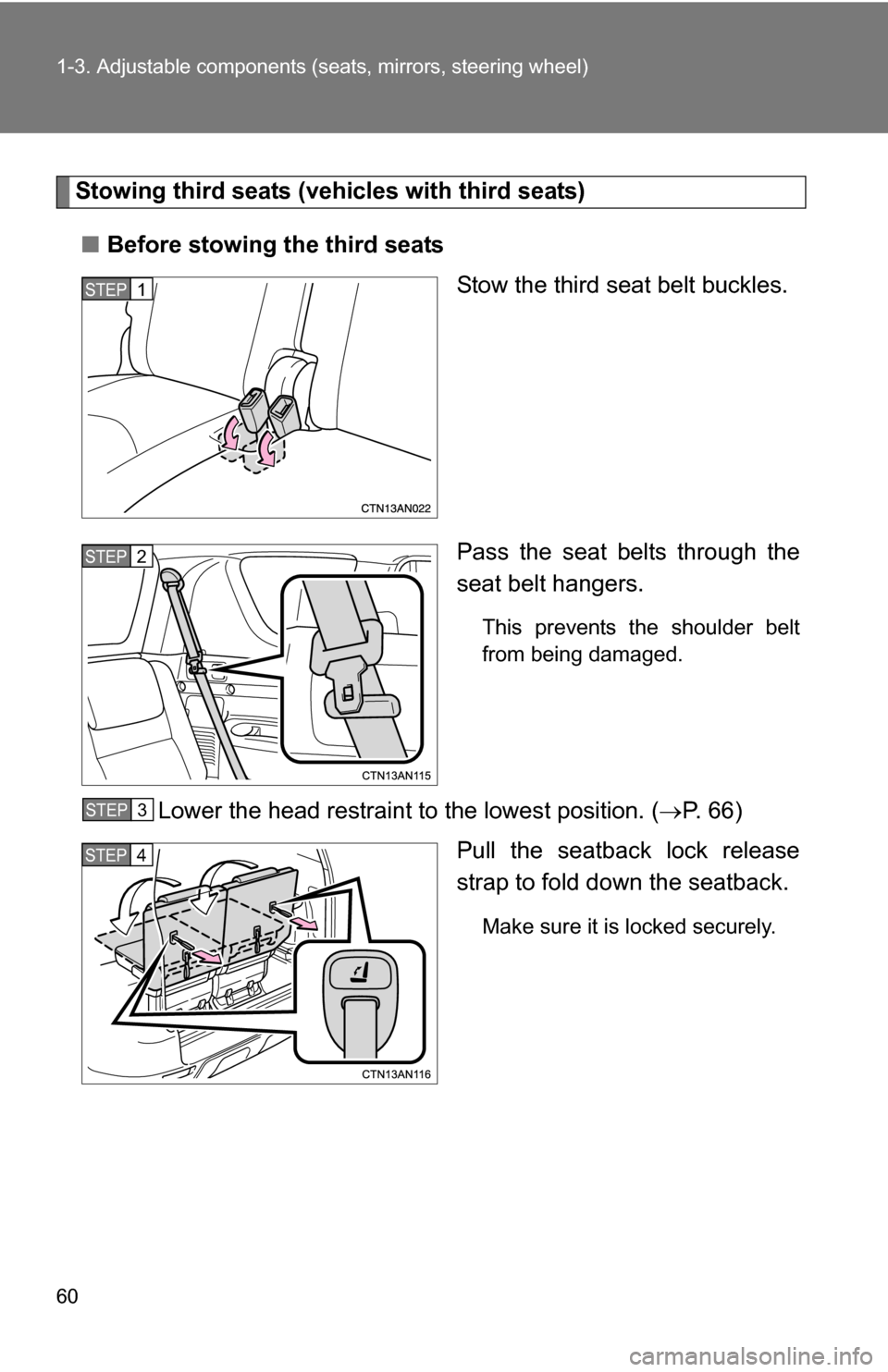
60 1-3. Adjustable components (seats, mirrors, steering wheel)
Stowing third seats (vehicles with third seats)
■ Before stowing the third seats
Stow the third seat belt buckles.
Pass the seat belts through the
seat belt hangers.
This prevents the shoulder belt
from being damaged.
Lower the head restraint to the lowest position. ( P. 66)
Pull the seatback lock release
strap to fold do wn the seatback.
Make sure it is locked securely.
STEP 1
STEP 2
STEP 3
STEP 4
Page 61 of 544
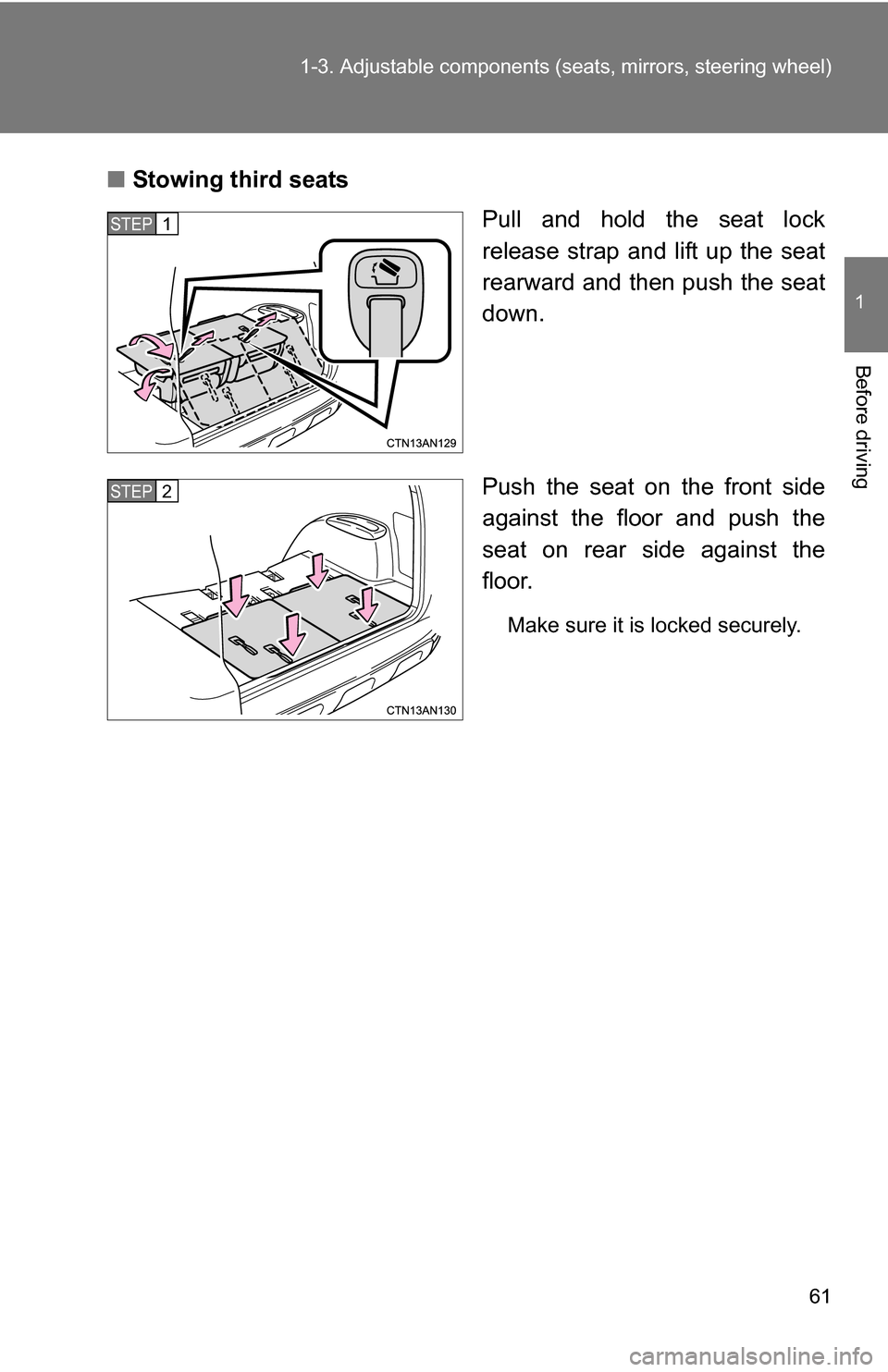
61
1-3. Adjustable components (s
eats, mirrors, steering wheel)
1
Before driving
■Stowing third seats
Pull and hold the seat lock
release strap and lift up the seat
rearward and then push the seat
down.
Push the seat on the front side
against the floor and push the
seat on rear side against the
floor.
Make sure it is locked securely.
STEP 1
STEP 2
Page 64 of 544
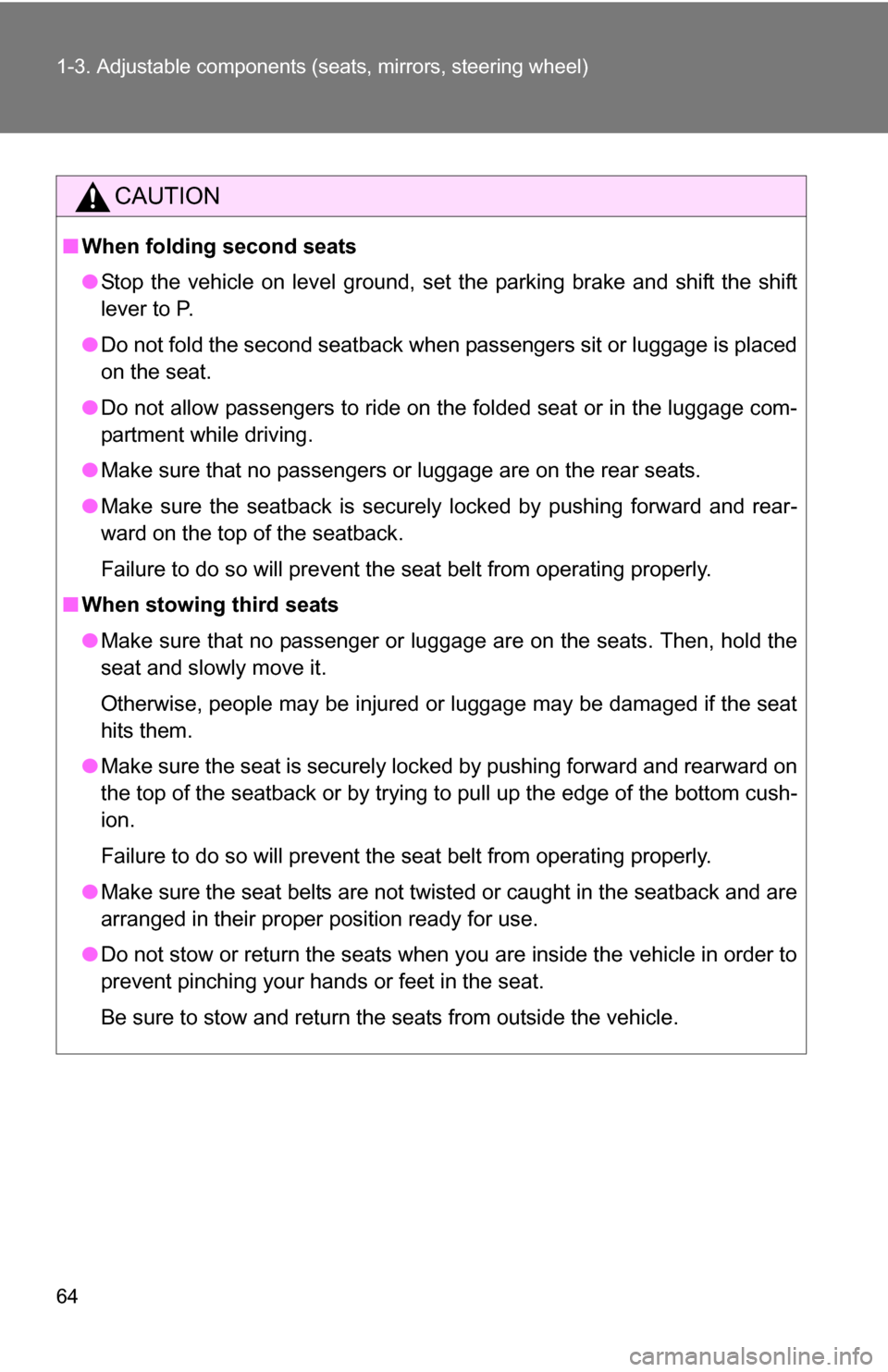
64 1-3. Adjustable components (seats, mirrors, steering wheel)
CAUTION
■When folding second seats
●Stop the vehicle on level ground, set the parking brake and shift the shift
lever to P.
● Do not fold the second seatback when passengers sit or luggage is placed
on the seat.
● Do not allow passengers to ride on the folded seat or in the luggage com-
partment while driving.
● Make sure that no passengers or luggage are on the rear seats.
● Make sure the seatback is securely locked by pushing forward and rear-
ward on the top of the seatback.
Failure to do so will prevent the seat belt from operating properly.
■ When stowing third seats
●Make sure that no passenger or luggage are on the seats. Then, hold the
seat and slowly move it.
Otherwise, people may be injured or luggage may be damaged if the seat
hits them.
● Make sure the seat is securely locked by pushing forward and rearward on
the top of the seatback or by trying to pull up the edge of the bottom cush-
ion.
Failure to do so will prevent the seat belt from operating properly.
● Make sure the seat belts are not twisted or caught in the seatback and are
arranged in their proper position ready for use.
● Do not stow or return the seats when you are inside the vehicle in order to
prevent pinching your hands or feet in the seat.
Be sure to stow and return the seats from outside the vehicle.
Page 65 of 544
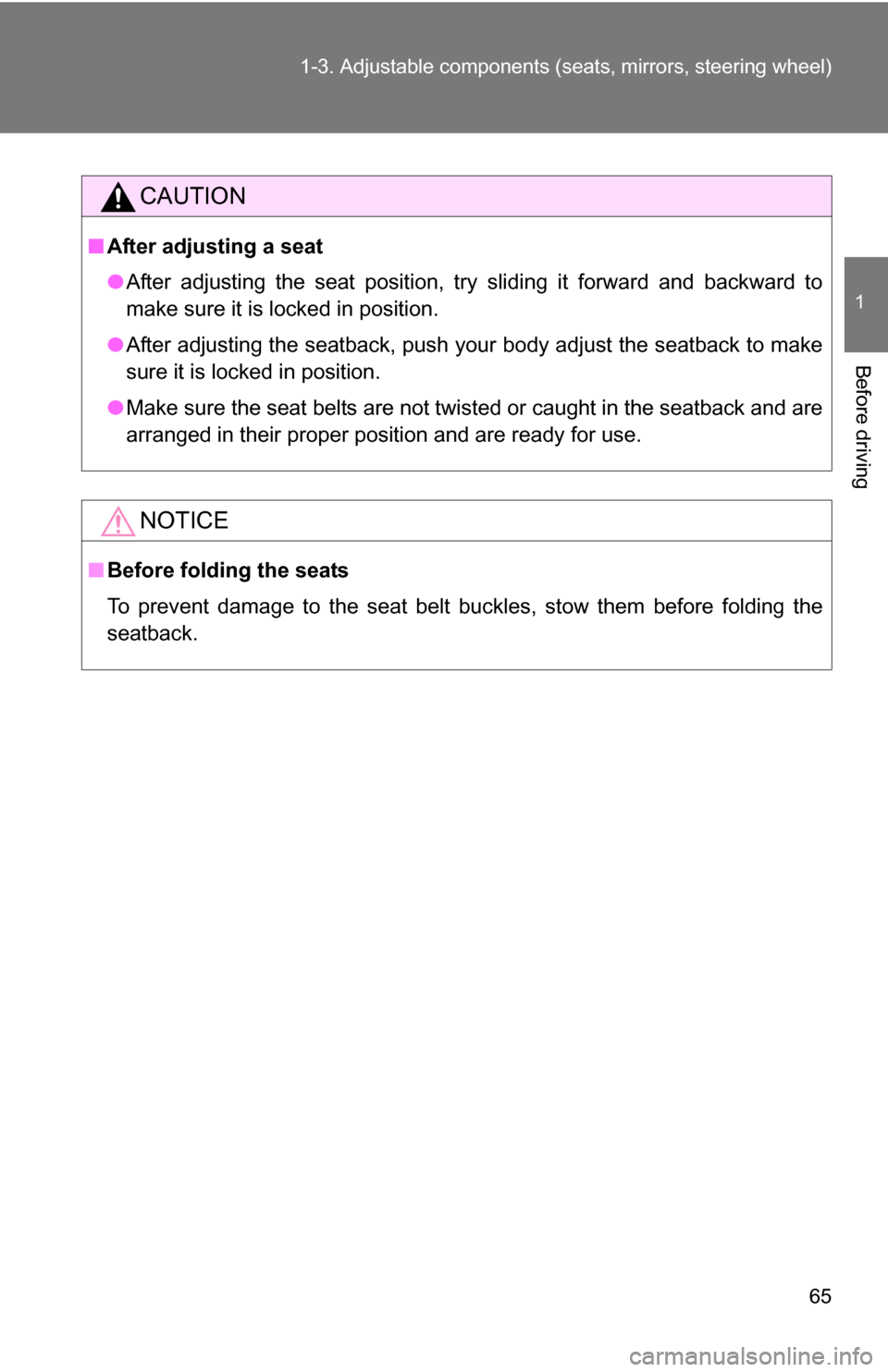
65
1-3. Adjustable components (s
eats, mirrors, steering wheel)
1
Before driving
CAUTION
■After adjusting a seat
●After adjusting the seat position, try sliding it forward and backward to
make sure it is locked in position.
● After adjusting the seatback, push your body adjust the seatback to make
sure it is locked in position.
● Make sure the seat belts are not twisted or caught in the seatback and are
arranged in their proper position and are ready for use.
NOTICE
■Before folding the seats
To prevent damage to the seat belt buckles, stow them before folding the
seatback.